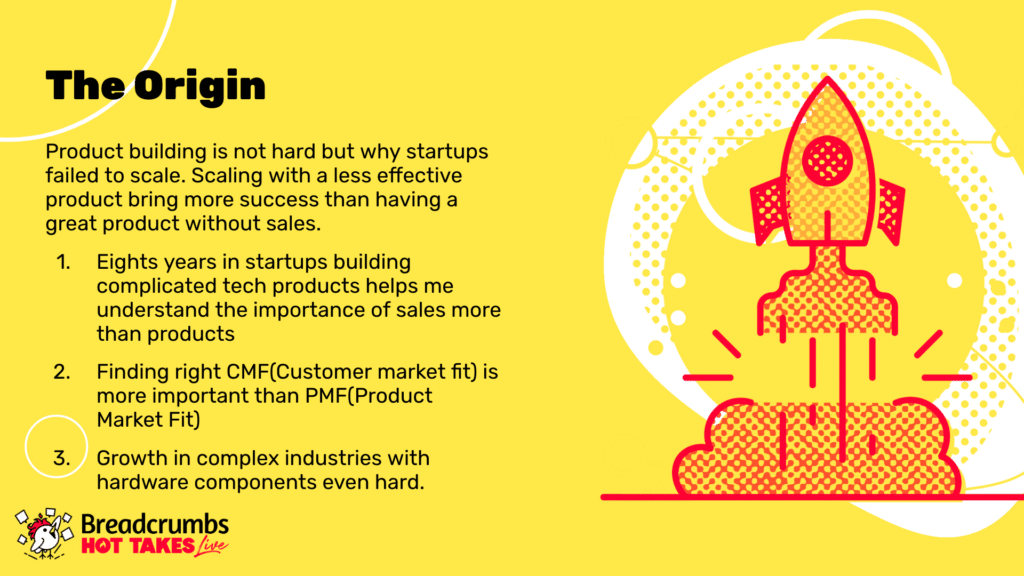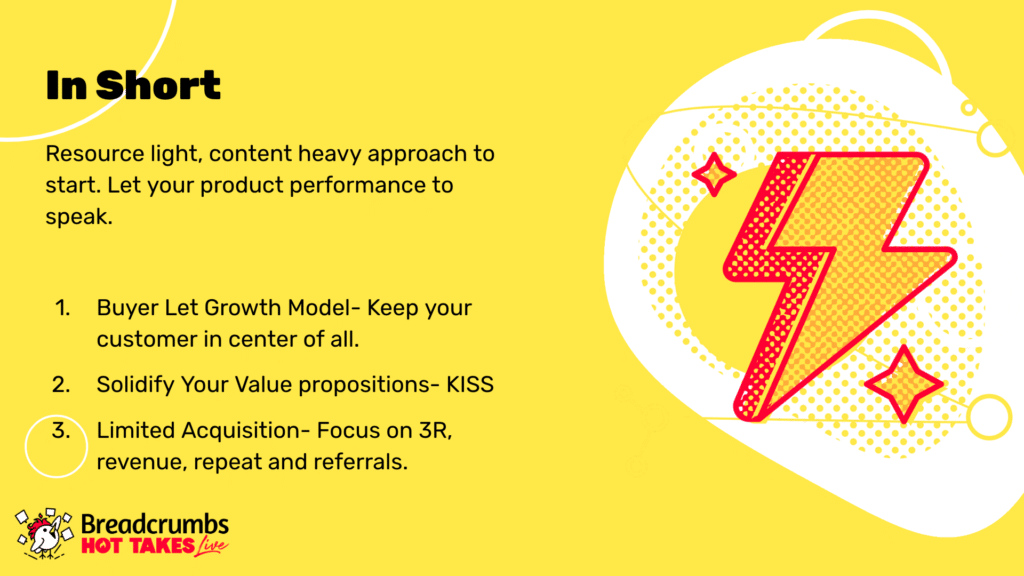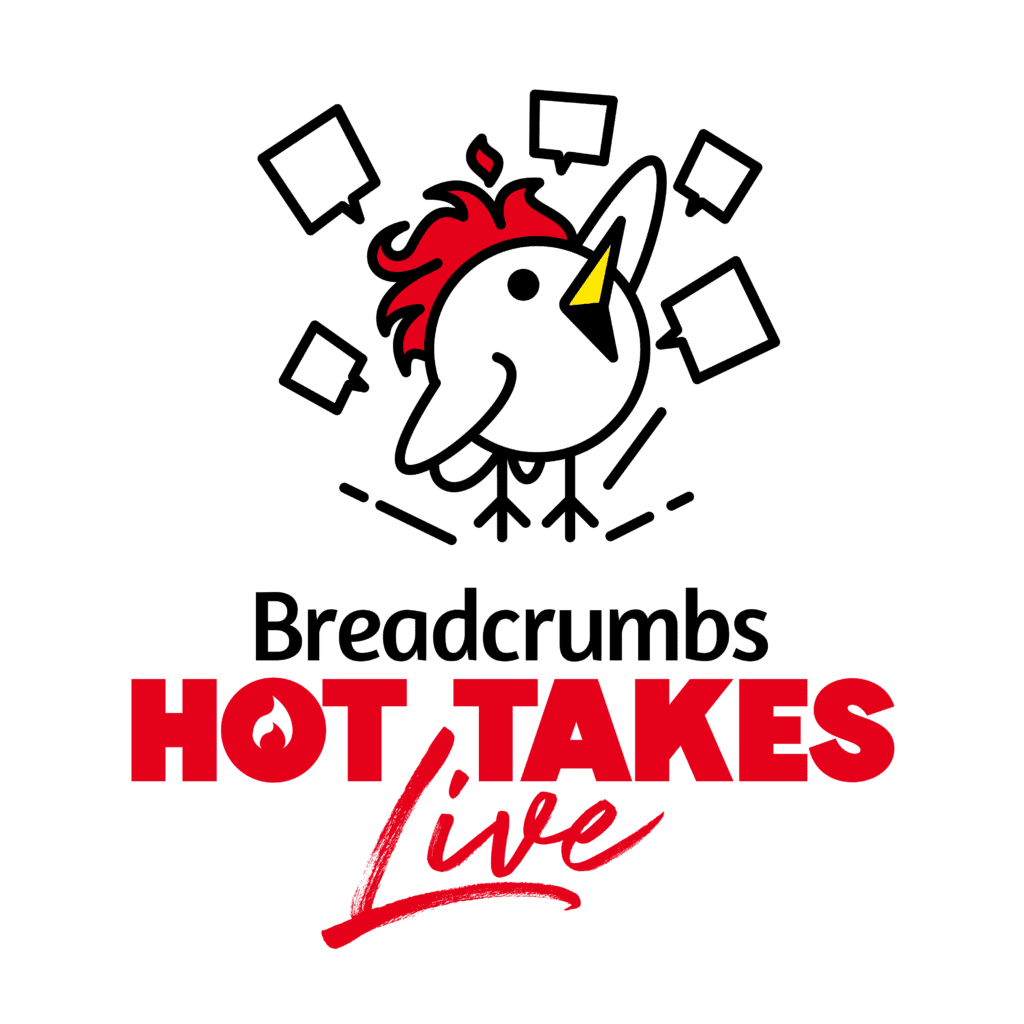Most early-stage startups got stuck at one level after the first few sales. Converting the early success to a repetitive growth formula is important for any SaaS startup.
In this session, Lalit Gautam, founder and CEO of Sensegrass, is going to talk about the few key mantras to come out from this block point and go for a ride on the success train.
[Transcript] The B2B SaaS Growth Roadmap
Although transcriptions are generally very accurate, just a friendly reminder that they could sometimes be incomplete or contain errors due to unclear audio or transcription inaccuracies.
Joe Aicher
I’m excited to have our next guest join us. I want to bring in Lalit, who will be doing his presentation on B2B SaaS growth hacks.
Lalit, welcome! It’s a pleasure to have you. I’m excited to hear about your presentation. Alright, and I will remove myself. Well, feel free to go ahead.
Lalit Gautam
Sure, thanks, Joe. Good evening, everyone. I hope you can hear me loud and clear and you can see my screen as well.
Joe Aicher
Yep, you’re good to go. I think we can see everything.
Lalit Gautam
Perfect, awesome, great. Hey, so good evening again. I’m the founder and CEO of Sensegrass. We’re building a climate tech platform to give very personalized recommendations to corporates. I’ll quickly come to the SaaS growth hacks, but I think what we’re going to discuss is important.
I know a lot of you have heard about this B2B SaaS growth kind of stuff. I know this is pretty common and popular in the startup world but it looks common and popular, but I think this is the most important tool we can figure out in any startup world.
Building a great product is fine, and finding a good market as well, but if you’re not hacking the growth, the revenue part in your startup, in your company, I think any great product will fail in the market. So we’re going to talk about these things. I’ll share my experience, especially from the perspective of a very complicated product that includes the hardware and software as well.
I’ll quickly introduce my background. I think this is an interesting part as well because it’s been eight years I’ve been into startups. My background is in pharmaceutical science and medicine. So, I’m not a tech or a hardcore coder. Then, I went for an MBA in international marketing and financial entrepreneurship. After working for corporates as a business development and business consultant for two years, I decided to go for startups.
Since around 2015, I started working on my first company. It was in e-commerce, and I think e-commerce was, even now, is one of the perfect examples of SaaS growth hacks.
After three years in e-commerce with some kind of machine learning and exponential growth, I sold my company. It was back in Paris, France. Then, I was working in other startups; I was helping some of them as a consultant because I signed a non-disclosure agreement after my first exit. This was also the time when product management, growth hacks, and SaaS growth were some of my key areas in helping startups. The biggest challenge startups usually face is building a product, but taking it to the next level is always difficult.
In 2019 and 2020, I started my second startup called Sensegrass. It’s a pretty complicated product and a highly technological product as well. We’re using our proprietary soil sensors and a lot of data from different private sources and combining this to give very personalized recommendations to corporates in agro and climate sectors, whether it’s large companies like Microsoft, banks like Morgan Stanley, growing food companies like PepsiCo, Cisco, to the courtroom as well.
I was born and grew up in India. I’ve lived half of my life out of India, especially in all these seven continents, including Antarctica. I’ve been there for a Robertson expedition.
There’s a funny thing that I’ve experienced from all these places as well. So, I’ve built companies in different regions of the world, but I’ve also lived and run these companies and helped these startups in these regions as well, especially Europe and the US, which are the major places where I’ve spent most of my time, but including Latin America as well, and Asia, being my Southern Asia as well.
Of course, I think one of the biggest learnings I have gained from my eight years of startup experience is that even if you have slow growth, your growth should be very gradual. You should keep going; you should always take small steps. If you’re not running, you should definitely take small steps as well. Your company growth should be in a positive direction. It should not be definitely in the negative direction, but it also should not be on a level where you just get stuck in one place.
So, I think that’s the most important learning. But let’s talk about the origin of this story, the origin of this growth strategy, the B2B SaaS growth strategy, and where it comes from. As I mentioned, I have worked in the e-commerce sector, and I have helped another startup in the energy and renewable thing. Then, I’m building the current company, which is purely a B2B SaaS company.

Right, and apart from this, I have mentored and helped almost 100 startups. I have invested in four startups myself, so pretty much like, you know, the SaaS approach is always there in the picture. This is a very common connect, or the common dot, which connects all these startups. It doesn’t matter if your company is in any part of the sector or any part of the world, whether it’s hardware, software, and all, or whether your business model is subscription-based, revenue, or licensing, or anything like that.
I think SaaS is the core of the startup world. B2B SaaS is most important. This is what investors love. So even if your company is in the D2C segment, or a B2C or B2G, whatever, I think you definitely have to bring an area or angle where you can consider yourself as a B2B as well. Because, as you can see on the right side, it’s the rocket that will take you to the next expansion growth.
So I think, as I mentioned earlier also, product building is not hard. You know, this is why startups, you know, I’ve seen a lot of great products, a lot of innovative products as well. People have built, but I think most of the startups usually fail because they do not implement it very well. Scaling with the most less effective product, like, you know, building a very simple or general product but making a great exponential growth or sales strategy, is the most important part as well.
So I think, as I mentioned, the eight years in startup building, especially with the complicated tech product, not a very simple SaaS CRM kind of approach, I think building tech products in a very complicated industry segment makes me very rigid about focusing more on the sales growth, as we’ll be going to talk about that.
The second important thing, I think, is that finding the right CMF (customer-market fit) is more important than the right PMF (product-market fit). So, Customer-market fit is more important than Product-Market fit. I’m sure you guys are like, what’s the customer-market fit, right? As we heard about the product market fit.
I think customer market fit is like a lot of times your product sometimes fits into one good market with some sort of clients. But if you really want to make it like repetitive sales, your product should be more CMF-focused, like customer market fit, where you can sell to the early adopters, but you can also do the retention with the same kind of customer. But you can easily and equally scale to the other types of markets.
Because if you stick to one market, which is your country, to one specific set of customers and if you are not able to expand to the different regions with the same kind of customer or different kinds of customers, I think that’s also one of the failures as well.
Growth in the complex industries, as I mentioned, like hardware or with the stack of course approach, or renewable energy or more AI in the focus or biotech, I think it’s also hard as well. So, if you’re building and if your startup is in these kinds of categories, I think you should definitely consider this workshop for sure.
So, let’s keep it very simple. I think we have a very limited time, so I think we have to focus on the more vital growth model, which means, like, you have to put your customer in the center of everything. “The customer is the king” is the line which you have to put in your mind because if you’re talking to yourself if you’re not talking to your customer, if you’re talking about the broader marketing strategies, good innovation technology, and all, but if you’re not talking to your customer, if you’re not getting the feedback, if you’re not making a customer-centric product, I think everything will fail as well.

And how are you going to do this? Solidify your value proposition. Keep it simple and clean. I think your value proposition should be the one where you have, even if you have just one value proposition in the product. I think you should have the one main value proposition in your product. You can keep it two or three maximum as a secondary value proposition, but the focus should be on the one as well.
The limited acquisition, which means like, focuses on the three Rs: revenue, repeat, and referrals. Why did you build a startup? Of course, for revenue. If your focus is not on the revenue and that repetitive revenue and revenue coming from the repeated revenue coming from the referrals, then it’s also a red flag. So your focus should be on your customer by bringing the solidified value proposition and bringing revenue from the repetitive revenues as well.
When, how are we going to get this? I think when we talk about this practice like, “Don’t take more than you can chew,” which means like, a lot of time, even I have made this mistake a lot of time where I try to bring more and more customers but not stick to the one sort of customer. I think you can just simply grow on your first few customers, do more and more repetitive sales, you know, getting like in a cookie-cutter approach, right?

Avoid these kinds of stuff. The gorilla growth hacking will take you there, which means you have to focus on the growth hacking from 360 degrees. Focus, which means that you have to take all these approaches from digital because if you’re living in the 21st century, you cannot simply adopt in 90s kind of growth model. So, even boring growth hacking is something that will take you to the 21st century. Is to focus on that.
KYC, Know Your Customers. If you don’t know your customers, you’ll fail. I think the most important KPI or outcome of a gorilla growth hacking model is to knowing your customers. So, the referrals through the marketing strategies, through the leads, and all.
And after knowing your customer, you have to set the right KPIs. Of course, you can learn a lot from your competitors: good competitors, bad competitors, successful competitors, failed competitors. But I think your competitor will help you to set the right KPIs as well.
Of course, you cannot simply depend on the competitor. You also have to know as a founder what is the right side of the KPI in your business as well.
I think that’s because I’ve already almost done it, but I think that one of the biggest key takeaways of this session is that growth and comfort do not coexist, which means if you really want to grow, you have to, a little bit, destabilize your comfort zone. You have to come out of your comfort zone.
A lot of times, I’m taking myself as an entrepreneur and current entrepreneurs. I have seen a lot of times, I was in my own comfort zone, and when I was in my own comfort zone, I was doing the easy, easy approaches, easy growth strategies, and everything. It will not take you to the next level. If you really want to have a very exponential growth from 1 million ARR to 10 million to a hundred to thousand million ARR, you have to challenge your comfort zone because both these things will not coexist.
So, I think I think that’s all from here. I’ll close it here from now, and this is the time for Q&A. I’m happy to take any questions.

Hot Takes Live
Replays
Catch the replay of Hot Takes Live, where 30 of the top SaaS leaders across Marketing, Sales, and RevOps revealed some of their most unpopular opinions about their niche.
These leaders shared what lessons they learned and how they disrupted their industry by going against the grain (and achieved better results in the process).
Joe Aicher
Thanks, Lalit. Yeah, I appreciate the presentation. But Lalit, quick question from me. This whole idea of ‘boiling the ocean’ has always been something on top of my mind when you are at a startup. You’re trying to do everything for everybody.
What are some things that you think about early in starting up these businesses to make sure you are keeping your focus on that customer and making sure that you’re not trying to do everything for everybody?
Lalit Gautam
Yeah, Joe, I think that’s very important. I think founders are usually greedy people, right? They want everything at one time. And I think the most important part is like, as I mentioned, you cannot chew more than your expectation or your appetite.
I think you have to understand what is my first five customers. A lot of mentors usually say, “Hey, sell to your friends and family.” I do not relate to this. I’m like, your friends and family are not going to be your customers, not going to be a repetitive customer, they’re not going to give you good feedback, right?
So, on the basis of, like, a lot of times, startups sell to friends and family. Of course, we have friends and family for a reason; they’re buying it, and you eventually get paid.
So, I think very simply, in short, pick your first five customers and do at least one repetitive sale with them. If you’re not able to do the repetitive sales with them, I think you should change your customer market fit or product market fit.
Joe Aicher
I think that’s great advice, making sure you can find somebody that is continuing to find the value of the product and is showing it with their pocketbook. I think that’s exactly right.
Great, well, thanks, Lalit. Thanks for the presentation. Lalit, thank you for joining us, and best of luck.
Lalit Gautam
Thanks for having me, bye.
